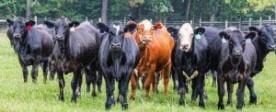By Andrea Osorio-Doblado and Darren D. Henry
Tannins can be perceived as “antinutritional factors” in ruminant diets. Indeed, they are; however, when they are provided from low to medium concentrations (< 50 g/kg DM) tannins can improve utilization of feed protein without impairing feed intake or carbohydrate digestibility and there is a potential to also decrease enteric methane emissions from livestock. Tannins can increase the quantity of dietary protein, especially essential amino acids, flowing to the small intestine. This is of high value because protein is usually the most expensive component in ruminant diets.

Tannins can be perceived as “antinutritional factors” in ruminant diets, however, when provided in low to medium concentrations tannins can positively influence animal performance.
Tannins as a mitigation strategy to reduce greenhouse gas emissions
Numerous scientists have reported enteric methane production being decreased with the use of tannins. For example, methane production per unit of dry matter was decreased by 17% in dairy cattle fed Lotus corniculatus, which is a legume known for its tannin content, when compared to ryegrass. In addition, this same group observed that cows consuming the Lotus corniculatus produced one-third more milk compared with cows consuming …
Continue reading Do tannins have a place in beef production?
Source : osu.edu